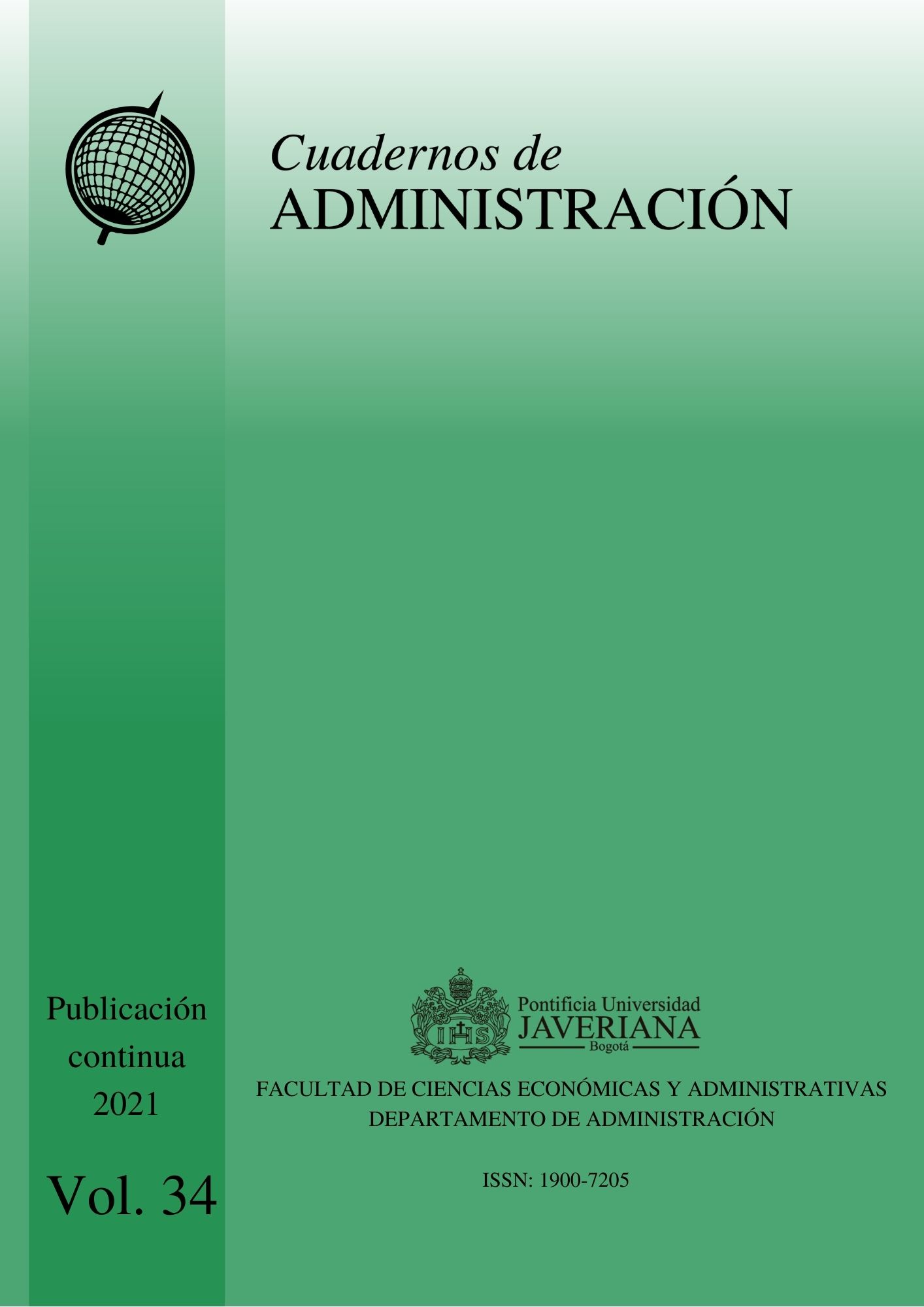Abstract
Data on innovation financing in Colombia present a paradox: Manufacturing companies prefer to finance their innovation projects with their own capital, with bank loans in second place, and cheaper public funding last. Extant financial theories cannot explain such a paradox (reversed pecking order), making a different approach necessary. Hence, a new perspective is presented on the basis of Sierra’s (2014, 2020) proposal. A fixed effects panel estimation is carried out that includes three new variables: A Knowledge Incorporation and Consolidation System, interaction among companies and funders, a particular type of investor (Dedicated). The results support the alternative explanation. Additionally, research possibilities, designs and applications of public and organisational policy aimed to overcome some of the problems mentioned are proposed.
Amit, R., Brander, J., & Zott, C. (1998). Why do venture capital firms exist? Theory and Canadian evidence. Journal of Business Venturing, 13, 441-466. https://doi.org/10.1016/S0883-9026(97)00061-X
ANIF Centro de Estudios Económicos (2017). La Gran Encuesta Pyme – Lectura Nacional. Informe de resultados 2do. Semestre 2017.
Barona, B., Rivera, J. A., Aguilera, C. (2015). Análisis de la relación de la innovación empresarial con la financiación en Colombia. Cuadernos de Administración, 28(50), 11-37. https://doi.org/10.11144/Javeriana.cao28-50.arie
Becchetti, L., & Sierra, J. (2002). Financing innovation: Trodden and unexplored paths. Cuadernos de Administracion, 15(24), 7-40. https://www.redalyc.org/articulo.oa?id=20515242
Bertoni, F., Colombo, M., & Grilli, L. (2011). Venture capital financing and the growth of high-tech start-ups: disentangling treatment from selection effects. Research Policy, 40(7), 1028-1043. https://doi.org/10.1016/j.respol.2011.03.008
Bertoni, F., & Tykvova,T. (2012). Which form of venture capital is most supportive of innovation? Discussion Paper 12-018, ZEW.
Bygrave, W., & Timmons, J. (1992). Venture capital at the crossroads. Boston, MA: Harvard Business School Press.
Eckhardt, J. T., Shane, S., & Delmar, F. (2006). Multistage selection and the financing of new ventures. Management Science, 52, 220-232. https://doi.org/10.1287/mnsc.1050.0478
García, D., Barona, B., & Madrid, A. (2013). Financiación de la innovación en las Mipyme iberoamericanas. Estudios Gerenciales, 29, 12-16. https://doi.org/10.1016/S0123-5923(13)70015-9
Gompers, P., & Lerner, J. (1998). Venture Capital Distributions: Short and Long run Reactions. Journal of Finance, 53, 2161-2183. https://doi.org/10.1111/0022-1082.00086
Gompers, P., & Learner, J. (2001). The venture capital revolution. Journal of Economic Perspectives, 15(2), 145-168. https://doi.org/10.1257/jep.15.2.145
Gulati, R., & Higgins, M. (2003). Which ties matter when? The contingent effects of interorganizational relationships on IPO success. Strategic Management Journal, 24, 127-144. https://doi.org/10.1002/smj.287
Hall, B. H., & Lerner, J. (2010). The financing of R&D and innovation. In: B. Hall & N. Rosenberg (eds.), The Handbook of the Economics of Innovation (pp. 610-639). Oxford: Elsevier.
Hallen, B. (2008). The causes and consequences of the initial network positions of new organizations: From whom do entrepreneurs receive investments. Administrative Science Quarterly, 53, 685-718. https://doi.org/10.2189/asqu.53.4.685
Hallen, B., & Eisendhardt, K. (2012). Catalyzing strategies and efficient tie formation: How entrepreneurial firms obtain investment ties. Academy of Management Journal, 55(1), 35-70. https://doi.org/10.5465/amj.2009.0620
Jiménez, L. F. (2008). Capital de riesgo e innovación en América Latina. Revista de la CEPAL, 96, 173-187. http://hdl.handle.net/11362/11287
Knockaert, M., Clarysse, B., & Wright, M. (2010). The extent and nature of heterogeneity of venture capital selection behaviour in new technology-based firms. R&D Management, 40(4), 357-371. https://doi.org/10.1111/j.1467-9310.2010.00607.x
Mina, A., & Lahr, H. (2011). Venture capital in Europe: Recovery, downsizing or breakdown? FINNOV Discussion Paper, Document FP7-SSH-2007-1.2.3-217466-FINNOV-D3.2.
Myers, S., & Majluf, N. (1984). Corporate financing decisions when firms have investment information that investment do not. Journal of Financial Economics, 13, 187-221. https://doi.org/10.1016/0304-405X(84)90023-0
OCyT - Pardo, C. I. & Cotte, A. (eds.) (2018) Science and Technology Indicators 2017, Observatorio Colombiano de Ciencia y Tecnología, Bogotá.
Otálora, D., Hurtado, R., & Quimbay, C. (2009). Interés de las empresas por la financiación de sus actividades de I+D+i: un análisis en el marco de las redes complejas para el sector industrial manufacturero colombiano. En: J. Robledo, F. Malaver & M. Vargas (eds.), Encuestas, datos y descubrimiento de conocimiento sobre la innovación en Colombia, Bogotá: Colciencias.
Powell, W., Koput, K., Bowie, J., & Smith-Doerr, L. (2002). The spatial clustering of science and capital: Accounting for biotech firm-venture capital relationships. Regional Studies, 36(3), 291-305. https://doi.org/10.1080/00343400220122089
Sau, L. (2007). New pecking order financing for innovative firms: an overview. Working Paper N. 02, Department of Economics, University of Turin, Italia.
Sierra, J. (2014). Financing innovation in bio-pharma: a sectoral systems approach. PhD Thesis, Manchester Business School, University of Manchester.
Sierra, J. (2018). La cuarta hélice y la financiación de la innovación. Journal of Economics, Finance and Administrative Science, 23(45), 128-137. https://doi.org/10.1108/JEFAS-01-2018-0014
Sierra, J. (2020). How financial systems and firm strategy impact the choice of innovation funding. European Journal of Innovation Management, 23(2), 251-272. https://doi.org/10.1108/EJIM-07-2018-0147
Sierra, J., Malaver, F., & Vargas, M. (2009) “La financiación de la innovación: un análisis a partir de la encuesta de innovación de Bogotá y Cundinamarca”, en J. Robledo, F. Malaver y M. Vargas (Eds.), Encuestas, datos y descubrimiento de conocimiento sobre la innovación en Colombia. Bogotá: Colciencias.
Superintendencia Financiera de Colombia (2017). Reporte de Inclusión Financiera 2016. Bogotá.
Superintendencia de Industria y Comercio - SIC, World Intellectual Property Organization, Departamento Nacional de Planeación, Instituto Colombiano Agropecuario, Dirección Nacional de Derechos de Autor, Ministerio de Relaciones Exteriores - Cancillería (2017). Reporte sobre la información en materia de Propiedad Intelectual en Colombia. Septiembre, Bogotá.
Tylecote, A., & Visintin, F. (2008). Corporate governance, finance and the technological advantage of nations. Routledge, Oxon (UK).
Ullah, F., Abbas, Q., & Akbar, S. (2009). The relevance of pecking order hypothesis for the financing of computer software and biotechnology small firms: Some UK evidence. International Entrepreneurship and Management Journal, 6(3), 301-315. https://doi.org/10.1007/s11365-008-0105-0

This work is licensed under a Creative Commons Attribution 4.0 International License.
Copyright (c) 2021 David Andrés Londoño Bedoya, Jaime Humberto Sierra-González, Juan Manuel García-Ospina


